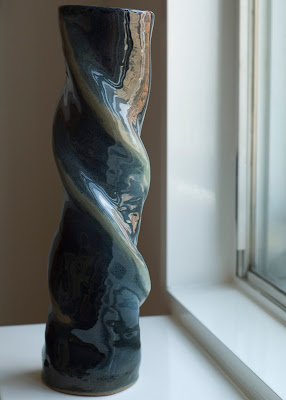So, I went in yesterday to fix the twisty vase's bottom where I could see I'd created a hole. I think it's good now, thanks to advice from my teacher and a little care on my part. I patched it up by scraping away some of the already drying clay so that the shavings went into the hole and completing that with a tiny coil and some slip. I decided to even out all the edges that way so that only the center has the twisty pattern and it has a decent foot upon which to sit. It's wrapped in plastic again for slow drying. I may have to do more smoothing, since it may end up with plastic wrinkles. I'm hopeful this time, since the seam held fine. My teacher would like to see the whole thing a little smoother, also.
I glazed these two little plates to go under my planter pots a while ago, but they still haven't come out of the kiln.

The brownish-looking glaze will be a rich brown, called New Tyler Amber, and the splashes are a faux celadon glaze that, when placed over the New Tyler Amber, make a cool speckled effect of green with brown speckles. They match the pots, currently sitting on plates that don't match (the one in the front is sitting on a plain yellow plate and the one in the back is sitting on a white plate with black painted swirls). Also, the current plates are full-size dinner plates, while the pots have diameters of probably less than six inches. The bottom of the pots is the New Tyler Amber and the top is the faux celadon over New Tyler Amber.

I attempted to ensure that the bottom view of the side of the pot still has the dark New Tyler Amber showing, but that the splashes of faux celadon make clear that these plates are specific to these pots. They are also proportionately sized.
If anyone needs planters like this, let me know. These are fairly easy. I can make different colors, of course.





















